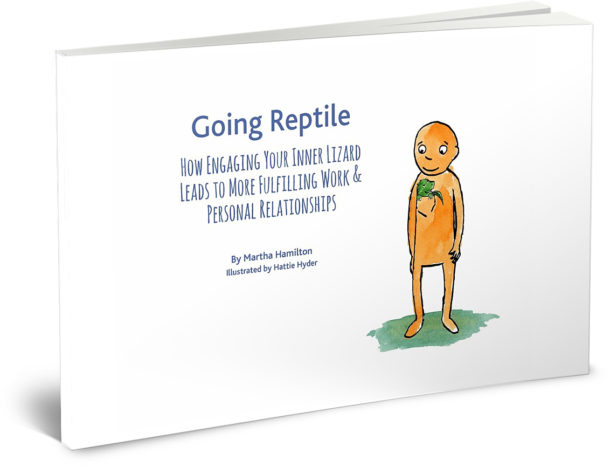In this series, we’ve been taking a look at the various ways that we react when we feel threatened. And in our world today, a world that is volatile, uncertain, complex and ambiguous (VUCA), feeling threatened has become a new form of normal for many of us. (New to the series? Catch up here)
As life speeds up, it’s becoming even more important to get to know HOW we show up when we’re feeling threatened so we can recognize what is happening and make the space in ourselves to respond differently. Some forms of reacting to perceived threat are easy to recognize. Others, not so easy. And, as we’ve been discovering in this blog series, when we react our access to our pre-frontal cortex is diminished. And our pre-frontal cortex is responsible for the higher human capacities that we need to navigate our increasingly complex world.
What can we do? Learn to recognize our subtle forms of reactivity, and learn to train our brains. By training our brain, we can bring more of our pre-frontal cortex online, helping us better navigate VUCA environments. In my book Going Reptile, I outline four main categories of reactivity, the Four F’s. Fight, Flight, Freeze and Fawn, and lay out 12 common reactive strategies, to help you recognize the more subtle forms of reactivity and diminishing access to our pre-frontal cortex.
In past posts we’ve looked at the first two of the Four F’s – Fight and Flight. In this post we’ll look at the
third and final style in the Freeze category: The Avoider.

This Style, which I call “The Avoider,” may well be where the phrase “No Problem” originated. People who exhibit this style do all they can to avoid feeling worried. For this style, being worried feels dangerous – so they simply don’t allow themselves to feel it or acknowledge it.
This serves us well when we’re a child, particularly if we’re needing to find ways to navigate an environment that doesn’t feel right for us. As a child, the world can feel quite threatening when caregivers are unable to fully contain what is arising. When caregivers cannot tolerate, for instance, fear, anxiety and worry, the child survives through adapting, and may learn to avoid feeling fear, anxiety, and worry. But, as adults, this can pose a challenge. In order to engage with others we need to be able to feel. And if we’ve learned not to feel in order to survive as children, we may still be living out this adaptive strategy as adults. We all have strategies that live on from childhood. The issue isn’t whether we have them. The question is whether or not these strategies still serve us as adults. And the first step is noticing what is happening.
I watch myself do this sometimes. Lately, I’ve been having this nagging sense that something doesn’t feel quite right – something is “off.” And it’s manifesting in a funny way. I don’t generally watch TV, but recently I’ve developed a small addiction to “The Good Wife.” I can see that this new TV habit is my way of avoiding something, although I don’t know what it is. And?
For some of us, avoidance is conscious. We watch ourselves avoid and get curious. What is it that I’m avoiding feeling? We live the question until it’s not there anymore, knowing that we may not ever clearly see the answer.
For others of us, the avoidance is automatic. We don’t realize we’re employing this strategy – it’s as if it’s happening to us. It just happens. We avoid, unaware of what we’re doing.
Indicators to look for: Hearing yourself or someone else say “It’s all good” when it’s clearly not all good. A refusal to acknowledge conflict. This can also show up as a movement toward repetitive, non-productive activities, like me watching multiple episodes of “The Good Wife.”
When there is something that needs to be addressed, whether it’s a conflict or a difficult emotion, and we avoid it, we start to pile up unresolved issues. The more that piles up, the more stressed we feel. The more stressed we feel, the more we avoid. At some point, our capacity to avoid will be overtaken by the piled up, unresolved issues we’ve accumulated. We then either need to revert to new avoidance tactics, or take a look at what’s happening for us. Either way, until we address the issues, our access to our pre-frontal cortex continues to diminish. It’s a challenging cycle that got created for good reason, at one time. The big question is whether it’s still serving us, and those around us.
It’s important to have compassion for ourselves and other people as we begin to notice and explore these Styles. The more we’re able to gently get to know what we and others do to feel safe, the better we’re able to stay connected – with our pre-frontal cortex online and be available for others.
Practice noticing, and being gentle. Notice if you find yourself getting judgmental, shaming yourself or others. It helps to see that one of the primary functions of judgment and shame is to keep old patterns in place. See if you can be compassionate with yourself and others. It’s only through gentle compassion that the patterns can loosen, as counter-intuitive as that may seem.
In our next post, we’ll move to the final of the Four F’s, the Fawn Styles.

